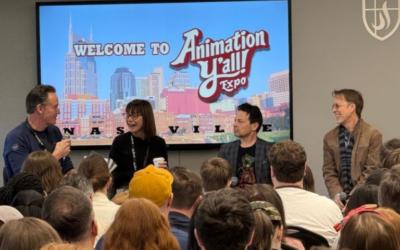SIGGRAPHITTI is the newsletter for the SIGGRAPH Conference and includes in-depth news, information, sneak peeks and previews of what you’ll find at SIGGRAPH 2015, a five-day interdisciplinary educational experience in the latest computer graphics and interactive techniques. Sign up to receive SIGGRAPHITTI and read on for Issue 2 Sneak Peeks.
And don’t forget to REGISTER NOW for SIGGRAPH 2015.
MUST-ATTEND COURSES AT SIGGRAPH 2015
SIGGRAPH 2015 attendees will discover a full range of fascinating, challenging instruction in every sub-discipline of computer graphics and interactive techniques in SIGGRAPH 2015 Courses. Courses are short (1.5 hours) or half-day (3.25 hours) structured sessions specifically designed to help attendees learn something new, or how to do something more efficiently, better, or faster than they could before.
Courses are specifically targeted for various levels of expertise and a variety of disciplines. People new to the field can attend beginning-level courses like the Fundamentals Seminar (an introduction to the foundations of computer graphics and interactive techniques) or Applying Color Theory to Digital Media and Visualization. Both are offered on the first day of the conference so attendees can attend more advanced courses during the week.
The full slate of specialized course topics includes recent advances in real-time rendering, Context-Aware 3D Gesture Recognition for Games and Virtual Reality, Modeling and Capturing the Human Body for Rendering, Health and Visualization, Computational Tools for 3D Printing, Pipeline Design Patterns, Bullet Physics Simulation, Multithreading for Visual Effects, How to Design and Build New Musical Interfaces, and an overview of Next-Generation APIs.
Course highlights include:
Efficient Real-Time Shading with Many Lights
Ola Olsson, Chalmers University of Technology; Emil Persson, Avalanche Studios; and Markus Billeter, Universität Zürich
Using many lights in real-time applications has been an important goal for many years. This course presents an in-depth, practical exposition that combines production experience from game developers with the latest research into efficient many-light algorithms for both desktop and mobile hardware.
Moving Mobile Graphics
Sam Martim, ARM Ltd.; Andrew Garrard, SAMSUNG Electronics Co. Ltd.; Andrew Gruber, Qualcomm Inc., Marius Bjorge, ARM Ltd.; Renaldas Zioma, Unity Technologies; Simon Benge, Exient; and Niklas Nummelin, Electronic Arts, Inc.
The state of the art in power-efficient mobile graphics technology, from hardware and software methodology to cutting-edge games development and graphics research, will be shared during this course.
Modeling and Toolpath Generation for Consumer-Level 3D Printing
H. Quynh Dinh, MakerBot Industries, LLC; Sylvain Lefebvre, INRIA; Filipp Gelman, MakerBot Industries, LLC; Frédéric Claux, INRIA
This overview of the challenges in Bouncy Castle developing a toolpath generator (slicer) for 3D printing describes software solutions for mechanical problems, properties of molten plastic that must be overcome, and optimizations to improve print time and reduce plastic usage.
An Overview of Next-Generation Graphics APIs
Chris Wyman, NVIDIA Corporation
Various next-generation, low-level graphics APIs are generating enthusiastic interest among developers. Early results show dramatic performance gains over prior APIs. This introductory course explains how to transition from current to next-gen APIs, compares similarities among next-gen APIs, summarizes API details in specific applications (DirectX12, Vulkan, etc.), reviews case studies, and includes a discussion session with spec writers and game developers. The course is appropriate for students who work with current graphics APIs as well as more experienced engineers.
WHAT EDUCATORS NEED TO KNOW AT SIGGRAPH 2015
The Educators Symposium (Sunday) highlights trends and research directions in American higher education. Today’s university labs and lecture halls are evolving into hybrid and collaborative problem-solving centers. Physical computing, computer science, and mechanical engineering are joining forces with art disciplines such as fashion and industrial design, and more traditional studio practices such as metalsmithing and furniture design to create curricula that represent today’s society and what it means to be human. The Educators Symposium explores the future of higher education’s role in developing student skills for a flexible, collaborative technological environment.
On Monday and Tuesday, educators are invited to meet for coffee before Birds of a Feather sessions on various topics, including:
Educating Individuals on Team Animation Projects
by Seth Holladay, Brigham Young University
At Brigham Young University, new computer animation students pursue individual or small-group projects, but senior-level students must work with 25-50 other students to create a five-minute animated short film. The transition from individual projects to a full-fledged production can be difficult. The purpose of the group project is to not only generate portfolio material, but also help students learn how to work with a team on complex productions as they develop the personal skills required for successful careers.
Technology Convergence and Instability
by Shaun Foster, Rochester Institute of Technology
This talk discusses how the accelerating creation of new technologies is causing moderate to high convergence and instability bounce house for sale among multiple fields. Following a broad overview, the talk highlights trends with several specific case studies.
Preparing Students for Industry Using Open Source and GitHub
by Harmony Li & Patrick Cozzi, University of Pennsylvania
The hiring process for software developers is changing. Employers want to see students’ source code, and GitHub is the place to find it. Since spring 2012, CIS565 at the University of Pennsylvania has used GitHub to improve students’ job prospects.
Interdisciplinary Coursework Combining Art and Technology – A Computer Science Perspective
by Joe Geigel, Rochester Institute of Technology
A computer science perspective on collaborative coursework that assigns interdisciplinary teams of computer science and art students to large-scale graphics projects. The talk focuses on best practices and lessons learned from a decade of offering such courses.
Find out more about EDUCATION FOCUS.



